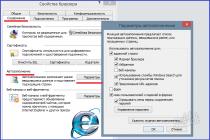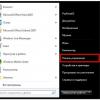Earlier this year, Nokia announced three Android devices at the Mobile World Congress, two of which, Nokia 5 and Nokia 6, we are comparing.
Which model should you choose? The more expensive Nokia 6, but with better performance and photography, or the Nokia 5, which is more affordable, but not as bright.
Nokia 5: pros and cons
- convenient operation;
- spectacular display;
- regular OS updates.
- quality of photography;
- long process of charge replenishment;
- "poor" equipment.

Nokia 6: pros and cons
- "long-playing" battery;
- photography;
- multitasking;
- sound quality.
- hybrid slot for a second SIM card;
- lack of stabilization during video filming;
- the processor is not for games.

And now directly to the comparison of the two models.
Price
When the devices were announced at MWC 2017, they not only received the attention they deserved, but also surprised fans of the brand with their price tag. Taking into account the high performance, the price of smartphones turned out to be quite acceptable. As of the date of the announcement, the cost of the Nokia 5 was € 190, and the Nokia 6 € 230, with the exception of the "cheapness" was a special model called "Arte Black" , the price of which was € 300. HMD Global wanted to impress, which is why this smartphone was launched, targeting the global market. The Arte Black has improved specifications (RAM and ROM), but the more significant difference from the other two models is the coating of the back of the case with a glossy glass material, which "flaunts" a massive fingerprint scanner.
As for the prices today, on the Yandex-market the average price of Nokia 5 is 12,990 rubles, Nokia 6 costs about 16,000 rubles.
Of course, you can find devices with similar technical characteristics and similar prices, but often these are no-name brands that do not differ in stylish design and display quality.
Display
Nokia 6 received a 5.5-inch IPS-display with Full HD resolution (1920 x 1080).

Nokia is equipped with a 5-inch 720p display (1280x720).

Both screens have 2.5D rounded edges. In addition, the screens are covered with Gorilla Glass. The Nokia 5 has a polarized layer that provides better contrast when the smartphone is exposed to direct sunlight.
The Nokia 5 has a maximum display brightness of 500 nits, while the Nokia 6, which has no polarized layer, has a display brightness of 450 nits. This is why the Nokia 6's screen is darker in daylight, but it has a higher contrast.

Hardware part
The Nokia 6 and Nokia 5 come with a Qualcomm-made processor designed for mid-range devices: Snapdragon 430 with eight Cortex-A53 cores, clock frequency 1.4 GHz and GPU Adreno 505.
Nokia 5 was given only 2 GB random access memory and 16 GB of permanent memory. The Nokia 6 comes with 3GB of RAM and 32GB of storage, while the Arte Black comes with 4GB / 64GB of storage.
Both devices perform well in synthetic tests. And given that they come with pure Android, their performance is standard for devices at this price point.
Nokia 6 and Nokia 5 announced with Android 7.1.1 Nougat, while the manufacturer promises the fastest update to new OS versions as soon as Google releases the update.
Preliminary installed applications no, except for Nokia support applications and virus protection.
Another one interesting information: HMD Global said that the developers decided to get rid of the LED indicator of missed notifications in the international version of Nokia 6. They assured that in many countries of the world this function is not used.
With regard to Nokia 6 (model for the global market), it was decided to get rid of indicator light, as a result of market research and research, - HMD Global.

Design
The Nokia 6 and Nokia 5 are housed in an aluminum body (6000 series) and are fantastic designs, modern and reliable. Mid-range devices have never looked as premium as the Nokia 5 and 6.
For aesthetic reasons, the aluminum edges of the Nokia 6 have been brushed, however, holding both smartphones in the hand feels comfortable. It is worth noting that both models have all the characteristics that Nokia could provide for this. price segment to "please" the market.
Camera
The Nokia 6 comes with a 16MP camera with f / 2.0 aperture, autofocus and 1μm pixel size.
Whereas Nokia 5 has the same camera specifications, but with a different sensor - 13 MP and a pixel size of 1.12 microns.
In addition, the Nokia 6 and Nokia 5 have dual-tone LED flash.
The front camera of these two models is equipped with an 8-megapixel sensor with autofocus, a resolution of 1.12 microns, f / 2.0 and a wide angle of image capture.

There is no indication of the PureView feature that was bundled with Nokia models Lumia has obviously kept them for a future flagship model. But, despite this, the cameras of the reviewed smartphones give excellent results for this price category.
Nokia's PureView is responsible for image quality and losslessness when zooming in. This means that the combination of a huge number of pixels is combined into one high quality pixel, but this requires a very high resolution sensor.
Both smartphones come with free Google Photo storage for Reserve copy images in the cloud with saving original size and the quality of the files.
Despite the fact that the pixels are smaller in the Nokia 6, its camera takes brighter pictures, but the quality of the Nokia 5 is not inferior. At the maximum magnification, the pictures of the Nokia 6 will slightly outperform the Nokia 5 in detail.
Conclusion
Nokia 5 is an elegant smartphone with good performance, enclosed in metal case... The manufacturer has made every effort to get a stylish device with a limited budget: the sleek body, made in a minimalist style by precision milling from a piece of aluminum, is admirable. Back cover completely "free" (antenna lines have moved to the bottom and top of the device). The manufacturer says that this is a smartphone for real life.
The Nokia 6 is a more powerful device with incredible reliability and a slightly improved camera. The smartphone is characterized by ergonomics, the perfect balance of performance and time autonomous work, durability and safety, unique sound reproduction technology (Dolby Atmos).

In an attempt to regain its former competitiveness, the Finnish company issued Nokia phones 5 and Nokia 6 based on Android OS. It should be noted that both models turned out to be very attractive both in terms of outward appearance, and by characteristics.
At first glance, it is not so easy to find the difference between these gadgets, since they are very similar in many factors:
Design concept
Aluminium case, safety glass, touch-sensitive and mechanical control buttons and elegant proportions make both smartphones very, very attractive for lovers of sophisticated style.
Performance
The gadgets are equipped with 8-core chips Qualcomm Snapdragon 430, which gives a good speed of work, and allow you to use even some heavy games and applications without any problems.
Autonomy
The latest Android updates, including version 7.1, are famous for their excellent optimization of resource-intensive processes. Due to this, batteries with a capacity of 3000 mAh are able to work without being connected to the mains for about 2 days.
Communication module
Interoperability with 4G LTE-A Cat. 4 is another notable similarity between the devices. High-speed Internet support is a significant plus for everyone modern smartphone.

Many similarities do not negate significant differences. In general, the ratio in a pair of Nokia 5 vs Nokia 6 is in favor of latest model, which is positioned by the company itself as a senior. Its advantages are manifested in the following:
- Increased memory. The combination of 3GB RAM and 32GB ROM undoubtedly seems more attractive than 2GB and 16GB. In this case, the memory in both cases is increased through microSD up to 128 GB.
- Improved display. Nokia 6 has a large 5.5-inch screen with Full resolution HD, while the younger model is 5.2 inches and HD format. Even with a simple comparison, the difference in image clarity and saturation is obvious.
- Powerful optics. The rear camera of the older model is designed for 16 megapixels, the younger - for 13 megapixels. At the same time, in the first case, the sensor is worked out a little better, so the pictures are more vivid and colorful.
- Two slots for SIM cards. An important parameter for many buyers is the number of SIM slots. Nokia 6 boasts support for two SIM cards, while Nokia 5 has got only one module.
The difference in cost between the devices is not very big: the 6th model has a price tag of 14 thousand rubles, the 5th - from 12 thousand rubles. At the same time, significant differences are only in the screen size and the amount of RAM. If these parameters are not important for you, then you should not overpay.
Either way, you get a smartphone from the reborn Nokia - a brand that has been proven reliable for decades.
TA-1003
TA-1025
TA-1039
Design
Information about the dimensions and weight of the device, presented in different units of measurement. Used materials, offered colors, certificates.
SIM card
A SIM card is used in mobile devices to store data that certifies the authenticity of mobile service subscribers.
Mobile networks
A mobile network is a radio system that allows multiple mobile devices to communicate with each other.
| Gsm | GSM 850 MHz GSM 900 MHz GSM 1800 MHz GSM 1900 MHz | GSM 850 MHz GSM 900 MHz GSM 1800 MHz GSM 1900 MHz |
| CDMA | CDMA 800 MHz | CDMA 800 MHz CDMA 1900 MHz |
| TD-SCDMA | TD-SCDMA 1880-1920 MHz TD-SCDMA 2010-2025 MHz | - |
| UMTS | UMTS 850 MHz UMTS 900 MHz UMTS 1900 MHz UMTS 2100 MHz | UMTS 850 MHz UMTS 900 MHz UMTS 1900 MHz UMTS 2100 MHz |
| LTE | LTE 850 MHz LTE 1800 MHz LTE 2100 MHz LTE-TDD 1900 MHz (B39) LTE-TDD 2300 MHz (B40) LTE-TDD 2500 MHz (B41) LTE-TDD 2600 MHz (B38) | LTE 850 MHz LTE 1700/2100 MHz LTE 1800 MHz LTE 1900 MHz LTE 2100 MHz LTE 2600 MHz LTE-TDD 1900 MHz (B39) LTE-TDD 2300 MHz (B40) LTE-TDD 2500 MHz (B41) LTE-TDD 2600 MHz (B38) |
Mobile technology and data rates
Communication between devices in mobile networks is carried out using technologies that provide different data transfer rates.
Operating system
An operating system is the system software that controls and coordinates the operation of hardware components in a device.
| Operating system (OS) | Android 7.0 Nougat Android 7.1.1 Nougat Android 8.0 Oreo Android 8.1 Oreo | Android 7.1.1 Nougat Android 8.0 Oreo Android 8.1 Oreo |
SoC (System on Chip)
A system on a chip (SoC) integrates all the major hardware components of a mobile device into a single chip.
| SoC (System on Chip) | Qualcomm Snapdragon 430 MSM8937 | Qualcomm Snapdragon 835 MSM8998 |
| Technological process | 28 nm | 10 nm |
| Processor (CPU) | 4x 1.4 GHz ARM Cortex-A53, 4x 1.1 GHz ARM Cortex-A53 | 4x 2.45 GHz Kryo 280, 4x 1.9 GHz Kryo 280 |
| Processor size | 64 bit | 64 bit |
| Instruction set architecture | ARMv8 | ARMv8-A |
| Level 1 cache (L1) | - | 32 kB + 32 kB |
| L2 cache | - | 3072 KB 3 MB |
| Number of processor cores | 8 | 8 |
| CPU clock speed | 1400 MHz | 2450 MHz |
| Graphics processing unit (GPU) | Qualcomm Adreno 505 | Qualcomm Adreno 540 |
| GPU clock speed | - | 710 MHz |
| The amount of random access memory (RAM) | 3 GB 4 GB | 4 GB 6 GB |
| Memory type (RAM) | LPDDR3 | LPDDR4X |
| Number of RAM channels | Single channel | Two-channel |
| RAM frequency | 800 MHz | 1866 MHz |
Built-in memory
Each mobile device has built-in (non-removable) fixed memory.
Screen
The screen of a mobile device is characterized by its technology, resolution, pixel density, diagonal length, color depth, etc.
| Type / technology | IPS | IPS |
| Diagonal | 5.5 in 139.7 mm 13.97 cm | 5.3 in 134.62 mm 13.46 cm |
| Width | 2.7 in 68.49 mm 6.85 cm | 2.6 in 66 mm 6.6 cm |
| Height | 4.79 in 121.76 mm 12.18 cm | 4.62 in 117.33 mm 11.73 cm |
| Aspect ratio | 1.778:1 16:9 | 1.778:1 16:9 |
| Permission | 1080 x 1920 pixels | 1440 x 2560 pixels |
| Pixel density | 401 ppi 157 ppcm | 554 ppi 217 ppcm |
| Color depth | 24 bit 16777216 flowers | 24 bit 16777216 flowers |
| Screen footprint | 71.67 % | 69.58 % |
| Other characteristics | Capacitive Multitouch Scratch resistant | Capacitive Multitouch Scratch resistant |
| Corning Gorilla Glass 3 2.5D curved glass screen 450 cd / m² | Corning Gorilla Glass 5 2.5D curved glass screen Always-On Display 700 cd / m² |
Sensors
Different sensors perform different quantitative measurements and convert physical metrics into signals that can be recognized by the mobile device.
Main camera
The main camera of a mobile device is usually located on the back of the body and is used for photo and video shooting.
| Sensor type | CMOS | CMOS |
| Sensor size | 4.74 x 3.56 mm 0.23 in | - |
| Pixel size | 1.029 μm 0.001029 mm | - |
| Crop factor | 7.29 | - |
| Diaphragm | f / 2 | f / 2 |
| Focal length | 3.57 mm 26.04 mm * (35 mm / full frame) | 3.58 mm |
| Flash type | Dual LED | Dual LED |
| Image Resolution | 4608 x 3456 pixels 15.93 megapixels | 4160 x 3120 pixels 12.98 megapixels |
| Video resolution | 1920 x 1080 pixels 2.07 megapixels | 3840 x 2160 pixels 8.29 megapixels |
| Video - frame rate / frames per second. | 30 frames / sec | 30 frames / sec |
| Specifications | Autofocus Burst shooting Digital zoom Geographic tags Panoramic shooting HDR shooting Touch focus Face recognition Adjusting the white balance ISO setting Exposure compensation Self-timer Scene selection mode | Autofocus Burst shooting Digital zoom Optical image stabilization Geographic tags Panoramic shooting HDR shooting Touch focus Face recognition Adjusting the white balance ISO setting Exposure compensation Self-timer Scene selection mode |
| Phase detection | Pixel size - 1.12 μm Phase detection Laser autofocus Carl zeiss lens Secondary rear camera - 13 MP (monochrome) Angle of view - 76.9 ° |
Additional camera
Additional cameras are usually mounted above the screen of the device and are used mainly for video calls, gesture recognition, etc.
Audio
Information about the type of speakers and audio technology supported by the device.
Radio
The radio of the mobile device is a built-in FM receiver.
Wi-Fi
Wi-Fi is a technology that enables wireless communication for transferring data over short distances between various devices.
USB
USB (Universal Serial Bus) is an industry standard that allows different electronic devices to exchange data.
Connecting devices
Information about other important connection technologies supported by the device.
Browser
A web browser is a software application for accessing and viewing information on the Internet.
Video file formats / codecs
Mobile devices support different video file formats and codecs, which respectively store and encode / decode digital video data.
Battery
Mobile device batteries differ in their capacity and technology. They provide the electrical charge required for their function.
| Capacity | 3000 mAh | 3090 mAh |
| Type of | Li-polymer | |
| Talk time 2G | 18 h 1080 minutes 0.8 days | 23 h 30 min 23.5 h 1410 minutes 1 days |
| Standby time 2G | 768 h 46080 mins 32 days | 208 h 48 min 208.8 h 12528 mins 8.7 days |
| Talk time 3G | 18 h 1080 minutes 0.8 days | 23 h 30 min 23.5 h 1410 minutes 1 days |
| 3G standby time | 768 h 46080 mins 32 days | 208 h 48 min 208.8 h 12528 mins 8.7 days |
| Adapter output power | 5V / 2A | 9 V / 2 A |
| Fast charging technology | - | Qualcomm Quick charge 3.0 |
| Specifications | Non-removable | Fast charging Non-removable |
Nokia 5 review: battery life, benchmarks. Camera, picture quality on the screen and sound quality in headphones. Main advantages and disadvantages.
In some matters budget smartphones, as well as the models of the middle market segment, are ready to offer the user more than the flagships. For example, more hours of battery life, a more durable case, or the same 3.5 mm audio jack, which some manufacturers for some reason considered an anachronism.
It remains to see which line of the conditional performance rating will send Nokia 5 Snapdragon processor 430. Testing the computing power of the CPU in the GeekBench 4.1 benchmark helps to understand the preliminary alignment of forces. The S625 (Moto G5 Plus) smartphone predictably easily outperforms the S430 rivals.
Nokia 5 in GeekBench 4.1 (multi-core)
Nokia 5 in GeekBench 4.1 (single-core)
Will a Nokia 5 owner be able to play games? At minimum settings, yes, and all thanks to the low screen resolution. HD resolution reduces the load on the graphics chip and allows you to pull out good fps numbers. Moreover, in this respect Nokia 5 is much more interesting. Nokia smartphone 6 because it looks at native resolution (FHD) graphic tests pretty pale.
GFX 3.1 Manhattan (onscreen)
GFX 3.1 Car Scene (onscreen)
Very indicative are the results in BaseMark X, a benchmark that evaluates the efficiency of the CPU-GPU combination. The advantage of phones based on Snapdragon 625 can be seen here with the naked eye. All models based on the Snapdragon 430 chipset, including the Nokia 5, lined up in a friendly line with approximately the same results.
Nokia 5 in BaseMark X
The last check is Antutu 6. This benchmark evaluates the effectiveness of the entire hardware part, and with reference to operating system(optimization of which can significantly affect the result).
The Nokia 5 in Antutu 6 initially had no chance of success, since the 2GB of RAM counts here and pulls the smartphone down. In the end, the phone was in last place, but in fairness it must be said that the performance of all smartphones on Snapdragon 430 differs by some penny, which can be safely neglected.
Nokia 5 in AnTuTu 6
Nokia 5: sound quality
A traditional page for audiophiles and ordinary fans of good music who want to listen to their favorite tracks in decent quality. Can you recommend Nokia 5 to a music lover? In general, yes.
The Nokia 5 delivers very clear sound with minimal harmonic distortion and uniform signal amplification across the entire frequency range. The sound quality is excellent both when connected to an external amplifier and in headphones. The only objective drawback is the low volume, which may not be enough for someone.
| CHO | Signal / Noise | DD | OIG | KII | |
|---|---|---|---|---|---|
| Nokia 5 (amplifier) | +0.02, -0.03 | -94.3 | 92.8 | 0.0035 | 0.019 |
| Nokia 5 (headphones) | +0.00, -0.09 | -92.4 | 89.9 | 0.0041 | 0.016 |
| Nokia 6 (amplifier) | +0.12, -0.11 | -91.8 | 89.8 | 0.0018 | 0.019 |
| Nokia 6 (headphones) | +0.06, -0.02 | -91.2 | 92.1 | 0.0022 | 0.017 |
| Redmi note 4x | +0.05, -0.04 | -90.6 | 91.9 | 0.0018 | 0.0086 |
| Redmi Note 4x (headphones) | +0.05, -0.03 | -96.3 | 90.5 | 0.0047 | 0.023 |
| Meizu MX6 | +0.10, -0.03 | -94.2 | 94.0 | 0.0019 | 0.0064 |
| Meizu MX6 (headphones) | +0.30, -0.07 | -92.5 | 93.0 | 0.810 | 0.271 |
Nokia 5 camera and sample photos
It is not worth demanding a lot from the camera of budget models, so we will evaluate the quality of the photo without being too strict. The 13 megapixel main module with a 2.0 aperture produces good pictures. Pleased with sufficient (not excessive) color saturation, balanced color reproduction, high sharpness and detail.
You can rate photos from Nokia 5 by examples, and you can see 100% crop.
Nokia 5: summary
So, in what questions can this state employee offer the user more? Let's go through the key points:
- High autonomy. More than 12 hours of active screen when watching videos and surfing the Web is a good indicator.
- Excellent build quality. The body is made in a metal monoblock, which favorably distinguishes it against the background of fragile "glass" flagships. The screen is covered with Gorilla Glass. Of course, there is no IP68 protection, but you cannot demand it in a phone for 200 bucks.
- High brightness and good readability of the screen in the sun.
- Excellent sound quality when connected to an amplifier and headphones.
- Almost stock Android version 7.1.1 without any branded shells.
There are also disadvantages of the Nokia 5 smartphone, and to some they may seem critical and become a decisive argument against buying:
- Only 2 GB of RAM.
- Only 16 GB internal memory, of which the user will have about 9 GB.
- Slow processor. To date, Snapdragon 430 produces results at the “lower end of the acceptable range” level.
- The screen resolution is 1280 x 720 pixels. The depth of black is poor.
- Insufficient volume in the headphones.
That's all for today. Thanks to everyone who read the material to the end. If you find inaccuracies or errors in the article, write in the comments, we will fix it. Thank you in advance.














